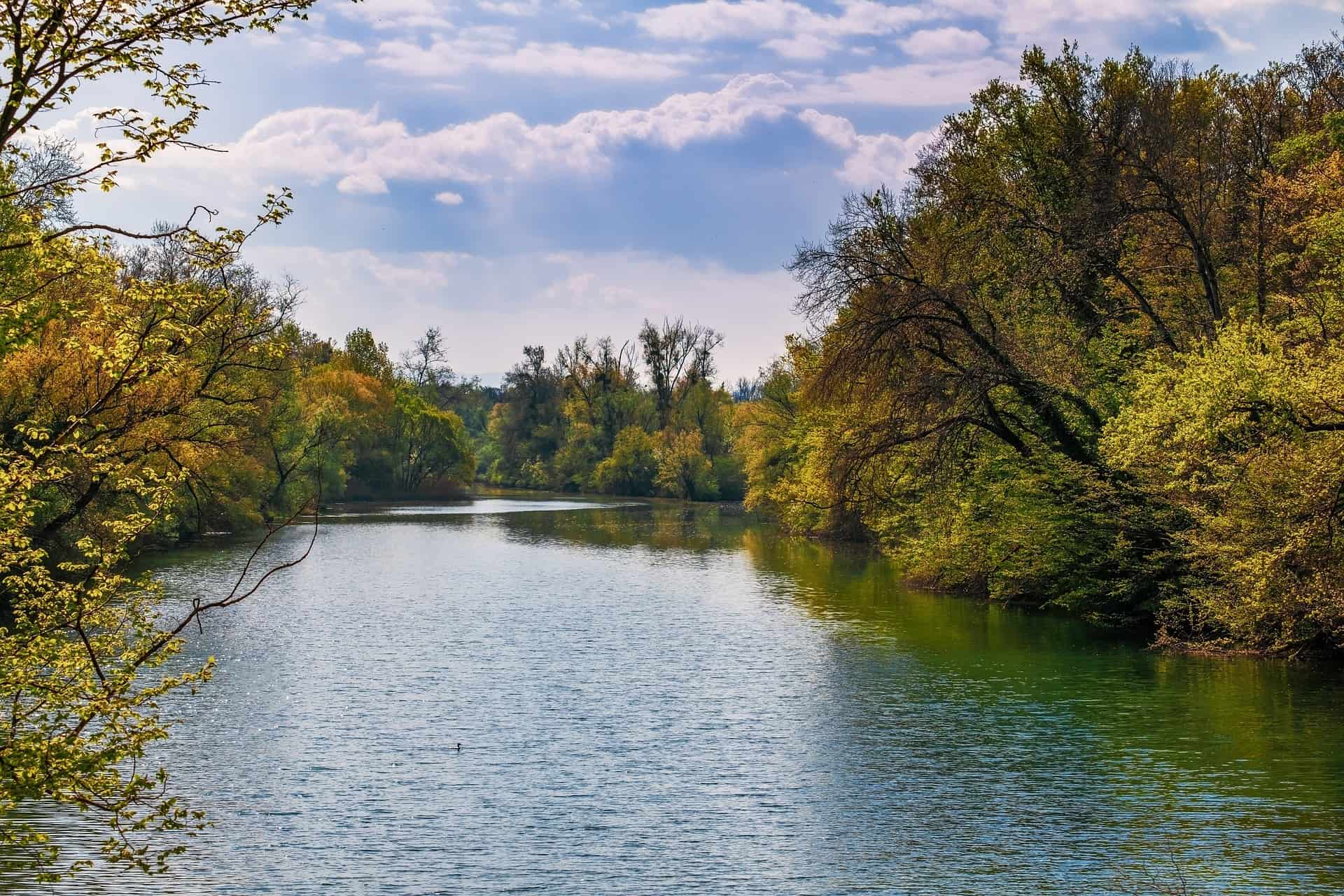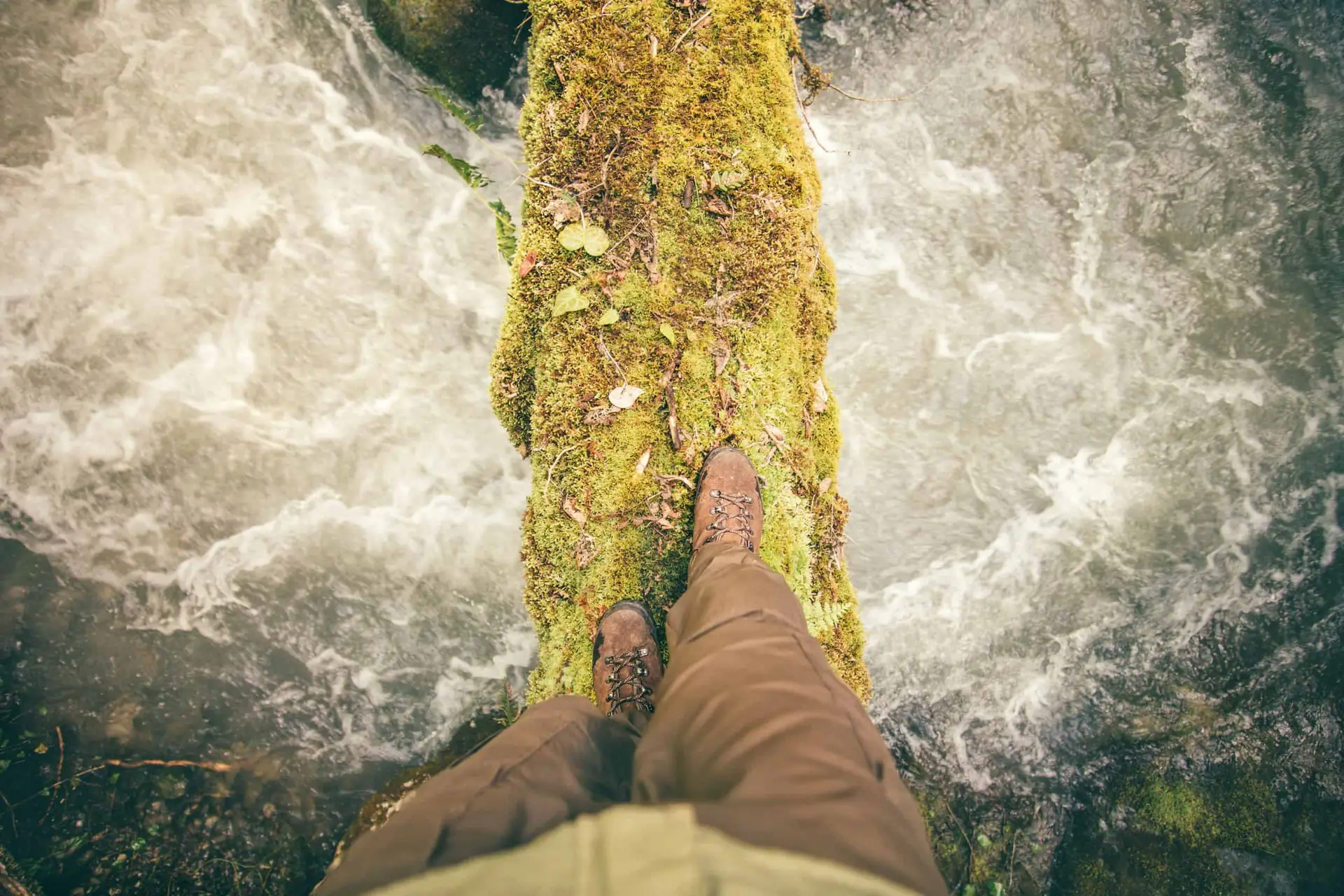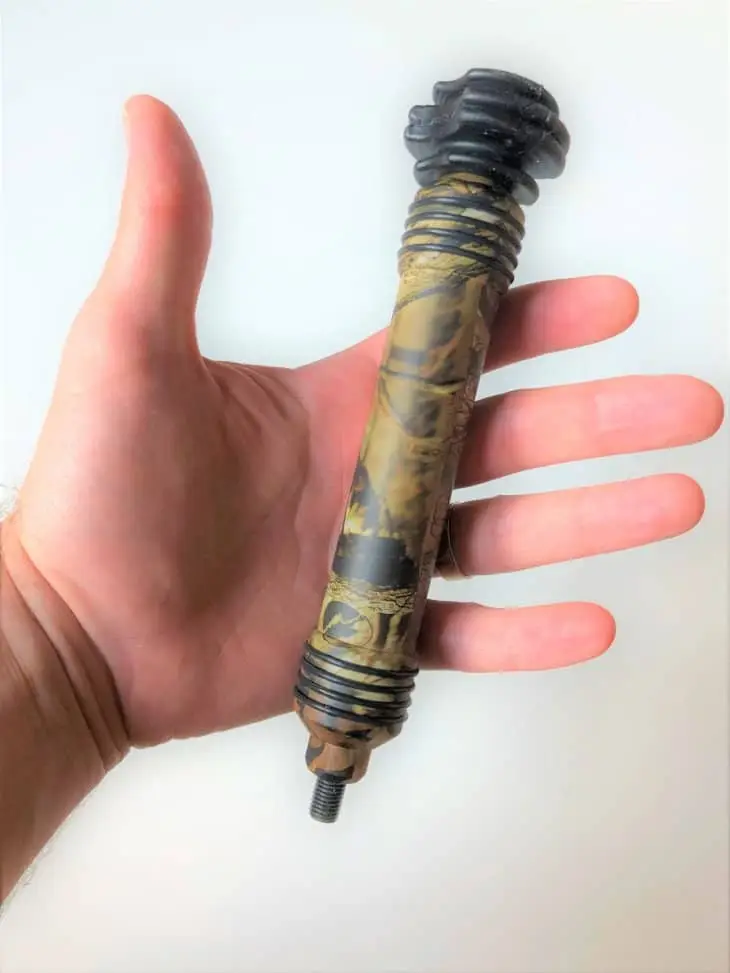
How many times have you lined up your bow, planted your feet, drawn the string all exactly the same way only to have your arrows land in completely different places? Bows are extremely sensitive, and even a small error in form, movement of the bow, or vibration could change your arrow’s trajectory. This is where bow stabilizers come in. As one of the most popular accessories for both compound and recurve bows, these simple devices can potentially improve both accuracy and stealth. Naturally, you need to figure out which is best for you.
An Overview of Stabilizers
As the name suggests, a stabilizer stabilizes your bow. It provides balance and minimizes vibration and therefore noise. You’ve probably noticed them any time you’ve seen professional archers in person or in photos. They look just like a long pole or rod sticking out from the bottom of the bow riser.
Despite their simple look, they actually have an elaborate construction and come in a wide variety of designs and styles. In general, a stabilizer consists of a screw used to mount it on the bow followed by a body of lightweight metal or carbon polymer that leads to a rubber dampener. Lastly, after the dampener, there is an end cap, usually made of aluminum, where you can attach steel weights. The weights themselves vary in shape from blunt cylinders to discs much wider than the body of the stabilizer, causing it to look like a plunger.
The weight the stabilizer adds to the bow helps keep it balanced. This is because bows don’t have much inertia. Inertia is the idea that an object at rest wants to remain at rest and it takes force to make it move. The more massive the object, the more force is required. Since bows tend to be so lightweight, the large amount of force that moves through them when they shoot an arrow makes them move a lot. The added mass of a stabilizer prevents some of this movement, meaning the archer can hold the bow more steadily.
The added weight also helps form. The stabilizer goes below the riser where you hold the bow and therefore pulls it down toward the ground. This keeps it oriented in a vertical straight line so you can more consistently line up your shots.
Lastly, stabilizers absorb noise and vibration produced by the bow. Much of the force that would normally travel through the limbs goes into the stabilizer instead, and many stabilizers include rubber dampeners that take this even further. Extra vibration can decrease accuracy by causing the arrow to waver, and for hunters, it can create noise that can spook nearby game.
The above reasons make stabilizers one of the most popular accessories for archers. Even though you can certainly shoot a bow without one, they can help you reach the higher levels of target archery and bowhunting thanks to the increased accuracy, balance, and stability as well as decreased vibration. That’s why you’ll almost always see professional archers and bowhunters using them. If you don’t know how to choose a bow stabilizer, there are a number of factors to consider.
Length
Stabilizers come in a wide variety of lengths, from anywhere as short as six inches to as long as 30 inches. In the end, archers choose stabilizers based mostly on personal preference. A longer stabilizer can usually provide more balance with less weight because it requires more torque and force to move.
Consider holding a weight out in front of you. The longer your arm, the farther you hold it out, the more difficult it is to hold up. The same is true with a bow. In this way, a long stabilizer can prevent more motion than a shorter stabilizer of the same weight. In other words, a longer stabilizer allows you to gain more stability for less weight.
Plus, longer stabilizers create a larger horizontal center of gravity. Since you hold your bow vertically so that it’s much taller than it is wide, this can really help with your form and balance.
Of course, it’s not all good. Longer stabilizers are considerably more inconvenient and considerably less maneuverable. With a long stabilizer, you’re likely to whack it on something if you swing the bow around. It’s also more likely to get in the way of other accessories like a quiver or scope. In the end, you’ll have to decide what’s best for your goals and purposes.
Weight
Stabilizers usually only weigh an ounce or two, but this is enough to provide considerable balance and stability. How much you want to use personally will depend on your own strength, how much stability you need, and your experience level.
Unless you’ve already been doing isometric shoulder exercises for years, you’ll probably have to work up to heavier stabilizer weights, even if you’re already a strong person. That’s because, while weight can prevent the bow from moving too much when it’s shot, it can cause your arm to waiver if you’re not used to holding it.
Luckily, many stabilizers come with multiple weights or at least the ability to purchase new weights and change them out. This way you can start small and work your way up as you perfect your form and accuracy.
You also have to consider how much balance you really need. Theoretically, if an archer had perfect form, they wouldn’t need a stabilizer, so you don’t want to overdo it. If you already have pretty good form, you could end up doing more harm than good by weighing yourself down. Similarly, if you’re getting a long stabilizer, you won’t need as much weight on the end. On the other hand, if you’ve found that your bow jumps a lot when you shoot and haven’t been able to correct it, higher weights may fix your issue.
Design
Although they all focus on the same principle, there are actually several different designs of bow stabilizers. Each has its advantages and disadvantages, so it’s best to choose the one that’s better for your personal situation.
Poker Stabilizers
These are long, thin stabilizers that attach to the bow just below your hand. Often they’re long enough to stabilize on their own, or they may have disc-shaped weights at the end. Due to their long length, small amounts of weight make a big difference. The main drawback is the awkwardness of the long length which can make it hard to change the position of the bow.
Twin Stabilizers
As the name suggests, a twin stabilizer setup involves two different stabilizers, each attached where the limbs meet the riser. Therefore, you have one right above your bow hand and one right below it. These are usually shorter than twin stabilizers, and the top is usually much shorter than the bottom.
Twin stabilizers provide an additional stabilizing effect. Specifically, they help with errors made with your bow hand and keep the bow better vertically aligned by not allowing it to rotate. Rotation can cause shots to veer to the right or left.
Additionally, twin stabilizers have a considerable dampening effect. Because there’s one for each limb, the vibration from each limb goes directly into one of the stabilizers. This not only eliminates noise but makes the shot feel smoother.
Reverse Stabilizers and Side Rods
It may seem like things are getting complicated, but this is what it takes to get the perfect shot. A reverse stabilizer is actually a smaller stabilizer that points in the opposite direction from a poker stabilizer. Essentially, it offsets the negative effects of the long-rod poker stabilizer. Though they provide increased balance and stability, the length of poker stabilizers can be difficult to hold up and can put your center of gravity too far in front of you. Reverse stabilizers bring these back to a manageable point.
Reverse stabilizers always extend back from the riser, but otherwise, archers and bowhunters use them to customize their setup in many different ways. As your archery skills improve, you quickly learn where you need more stability in the bow, usually where it turns or wavers as the arrow leaves. This can be a bit different for each person, so you’re likely to see either one or two side rods attached to archers’ risers at all sorts of angles, often even horizontal to the long rod.
Stiffness
Stiffness is one of the most important qualities to look for in a stabilizer. That is to say, it should be very difficult to bend. Intuitively, the stiffer the more stable, and this translates to your bow as well. As a general rule, the rod of your stabilizer should be as stiff, thin and light as you can get it. This will maximize the effectiveness of the weights at the end of the stabilizer.
Competition Shooting or Bowhunting
Although it ultimately comes down to personal preference, competition shooters and regular bowhunters tend to use different stabilizer setups. This is because bowhunters usually have a list of needs and concerns that don’t apply to competition archers, who want to concentrate 100% on accuracy. Because it will also depend heavily on what kind of bow you’re using, we’ll cover this more in the compound and recurve bow sections.
Compound or Recurve
While the majority of stabilizers work for both compound and recurve bows, some work better for certain models than others. There’s also the issue of what prefabricated options the bow has for attachments. This is one of the biggest points you need to pay attention to, so let’s dive into it in a bit more detail.
Stabilizers for Recurve Bows
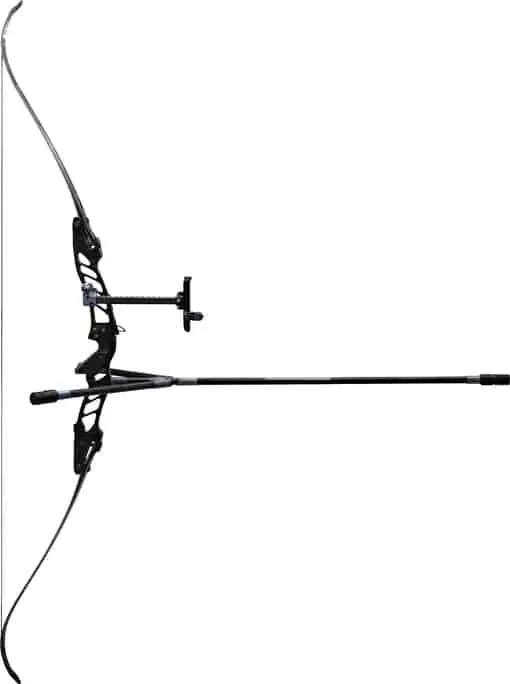
Recurve bows can benefit greatly from stabilizers. That’s because, compared to compound bows, they’re simply much harder to hold steady. The high absolute draw weights are a lot for your arms to manage, and each shot is slightly different since there’s no exact draw length. As a result, it’s normal for recurve archers to rotate their bows and make minor errors in their form.
The most common setup for recurve bows is known as the “V-bar.” This consists of a single long-rod poker riser with two side bars extending from the base. Manufacturers often sell V-bars in one attachable piece, but the side bars are usually adjustable. The right angle for your side bars is a matter of trial and error.
Still, there are many options, and when deciding how to choose a bow stabilizer, a lot also depends on what you’re using the bow for.
Competition Shooting
Accuracy is the name of the game for competition shooting, so there’s no reason to go all out. You can go for an all-in-one V-bar or buy separate poker and side bar stabilizers. What’s important, though, is that the stabilizer be adjustable. That means the weight at the end of the stabilizer as well as the angles of the side bars. As your form improves, you can then decrease the weight or even remove the side bars. As for the poker stabilizer, there’s no reason not to get one as long and thin as possible to maximize the effectiveness of the weight.
Bowhunting
Bowhunters need accuracy and stability, but they also have to pay attention to other things. Recurve bowhunters especially like recurve bows for their simplicity and often use them for long, primitive hunting trips in the deep wilderness. In this case, a long stabilizer can get in the way. Plus, it’s easy to knock against your tree stand or the leaves and cause enough noise to scare away nearby game.
For these reasons, if you’re a recurve bowhunter, the best stabilizer is going to be short. Pay special attention to the rubber dampener on the stabilizer, too. You want a good one because noise elimination is extra important for bowhunters. As an aside, it’s worth looking for a stabilizer with a camo finish or at least a mellow wood color to match your bow.
Stabilizers for Compound Bows
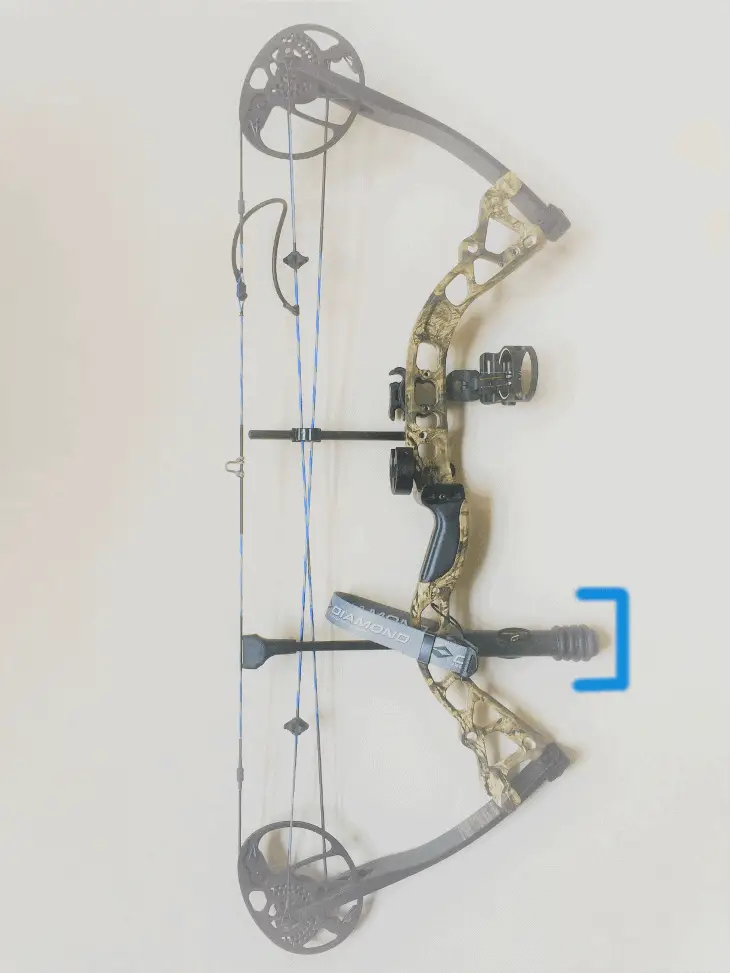
Thanks to their elaborate cam systems, compound bows have a lot more power than recurve bows. Consequently, they need stronger stabilizers. That means stiffness is a big part of how to choose a bow stabilizer for compound bows.
As for setup, compound bows usually come with a number of thread holes for accessories, so there’s a wide variety of ways to attach stabilizers. Like recurve bows, V-bars work perfectly well. Other compound bow archers like putting side bars at the bottom of the lower riser. Twin stabilizers are also common. It really depends on your form and where you need stability, as well as your activities.
Competition Shooting
Just like with recurve bows, there’s nothing stopping you from decking your compound bow out as elaborately as possible to improve stability and therefore accuracy. Making sure the stabilizer has a small diameter will help a lot, but you have to make sure it’s still stiff. Other than that, go for the longer stabilizers because they provide more stability and have few downsides within the scope of target archery.
Bowhunting
Unlike recurve bows, compound bows are not renowned for their simplicity. Most compound bowhunters tack on as many accessories as they can to increase their chances of getting their quarry, stabilizers included.
Once again, shorter is probably better. Not only is it less likely to hit and brush against things, but shorter stabilizers are better at dampening noise and vibration. With the considerable power of modern compound bows, this is pretty important.
The main difference when it comes to compound bows is consistency. The let-off provides a consistent draw length and therefore a consistent shot. With a scope and consistent form, you’re much more likely to hit your quarry in the kill zone. For this reason, a short poker stabilizer is a good idea, complemented by side bars and twin stabilizers as needed to prevent minor errors in form. It’s actually important to consider your other accessories as well when choosing a stabilizer. For example, a heavy quiver behind your riser may eliminate the need for a reverse stabilizer.
Since you’re hunting, it never hurts to go with a camo finish, either.
Find What’s Right for You
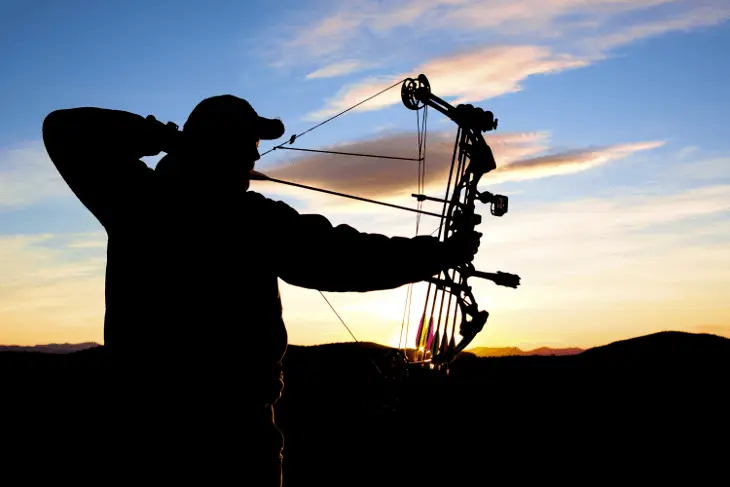
If you take anything away from this guide, it should be that stabilizers come in a wide variety of designs and an even wider variety of setups. This isn’t to make things complicated. Rather, every archer is different. We all have different quirks in our form that affect accuracy. The great thing about stabilizers is they can be adjusted and combined to provide you balance right where you need it, giving you the most stable bow possible. Finding this setup is a matter of learning your body and bow and going through trial and error. In the end, it could make the difference in landing that bullseye shot or taking home that trophy buck.


